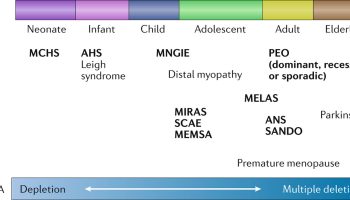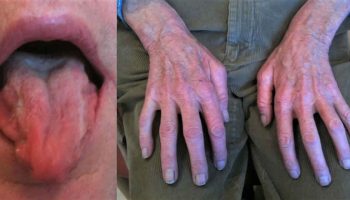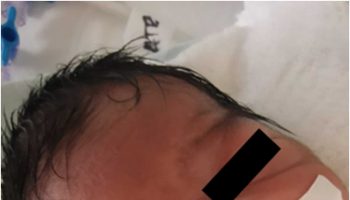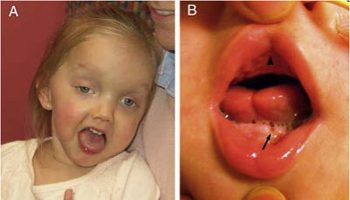Cotard syndrome
Cotard syndrome also known as walking corpse syndrome, Cotard delusion or Cotard’s syndrome, is a rare neuropsychiatric condition that was first described by Dr. Jules Cotard in 1882 in which the patient denies his or her own existence or the existence of their body parts 1. Cotard syndrome is often described as the delusional belief that one is dead or non-existent 2. However, Jules Cotard’s initial description of the “delusion of negations” was much richer and also involved delusions and claims of immortality and enormity, feelings of damnation, and illusions of bodily dissolution and transformation. Alternatively conceived as an extreme case of depression, hypochondria, or psychosis, Cotard syndrome is considered rare and remains poorly understood.
Cotard’s syndrome comprises any one of a series of delusions that range from a belief that one has lost organs, blood, or body parts to insisting that one has lost one’s soul or is dead 3. Cotard syndrome is characterized by anxious melancholia, ideas of damnation or rejection, insensitivity to pain, and nihilistic delusions concerning one’s own body or existence 4. While Cotard syndrome was first described over a decade ago, the literature remains scarce, with the continued need for informative case reports. Cotard syndrome cases have been reported in patients with mood disorders, psychotic disorders, and medical conditions. Most cases of Cotard’s are more responsive to electroconvulsive treatment (ECT) than to pharmacological treatment 3.
Though described initially in 1880, very little is understood about Cotard syndrome and it is not listed as a specific disorder in the Diagnostic and Statistical Manual of Mental Disorders, Fifth Edition (DSM-V) published in 2013 5. The current status of Cotard’s syndrome is its conceptualization as a manifestation of an underlying disorder. While Cotard syndrome is often described as being a psychiatric syndrome, published studies have shown a strong correlation between a preexisting neurological disease and Cotard syndrome 6. A variety of associated neurological conditions have been described, including migraines 7, subdural hemorrhage 8, cerebral atrophy 9, cerebral arterio-venous malformation 10, multiple sclerosis 11, cerebral infarction 12, superior sagittal sinus thrombosis 13, parietal lobe tumor 14, temporal lobe epilepsy 10, Parkinson’s disease 15, encephalopathy 16 and brain injury 17.
It is becoming more accepted that Cotard syndrome is a symptom of an underlying disorder. The symptoms and course of Cotard syndrome vary from ideas of spontaneous destruction of organs, body, and soul to the complete denial of one’s existence 18. Subsequently, some patients may cease to eat and may have increased tendency toward self-mutilation or suicidal behavior. Understanding Cotard’s syndrome and its connection to other neurological conditions is essential to identifying appropriate treatment modalities.
Cotard’s syndrome causes
A majority (64%) of Cotard syndrome patients presented with right-sided or bilateral changes 5. This is an important finding that adds to the growing literature on delusional misidentification syndromes, under which some posit that Cotard’s syndrome falls 19. Additionally, studies have demonstrated trends of increased bilateral cerebral atrophy and median frontal lobe atrophy in particular in patients diagnosed with Cotard syndrome 20. Researchers also found the most commonly affected region was the frontal lobe (36% bilaterally or right-sided), although other areas were involved, as well 5. Bilateral cerebral atrophy was found in four out of 11 patients (36%). Vascular lesions seemed to be the most common change seen, especially on the right side; this aligns with the findings of several reports 12.
Right frontal damage has been reported in those with delusional misidentification 19. Cotard syndrome falls under the category of hypofamiliarity delusions of self in terms of delusional misidentification syndromes 19. A “two-hit” hypothesis has been suggested for delusional misidentification syndromes, in which the first hit produces abnormal perception and the second hit leads to persistence of the abnormal perception despite being presented evidence to the contrary 19. The pathophysiology of some of these identified syndromes involves disconnections in the neural circuits involved in perception of self, with potential explanations citing that delusional misidentification syndromes, in particular hypofamiliarity delusions, result from an inability to link perceptions of external or environmental stimuli with internally generated autobiographical memories 21. Studies cite that a deep right frontal lesion could disrupt the anatomic connection between temporal and limbic regions and the damaged frontal lobe; this disconnection could result in a disturbance in familiarity of self, people, places, objects, and so on, and the occurrence of frontal lobe injury could lead to a problem with resolving the cognitive conflict 22. Lesions specifically of the nondominant hemisphere have also been implicated in Cotard syndrome 23, indicating that the findings of nondominant hemisphere changes may indeed be significant. Furthermore, delusional misidentification syndromes have been shown to simultaneously co-occur in previously published literature 19. A case study noted a patient who presented with both Capgras and Cotard delusions, both of which are classified as hypofamiliarity syndromes 19.
Previous publications on the topic of Cotard syndrome have shown an association with headaches 7, seizures 10, sagittal sinus thrombosis 13, cerebral atrophy 9, encephalopathy 16, infarction 12, catatonia 24 and Capgras syndrome 12. Additionally, other potential diagnostic associations reported, including dehydration, steroid psychosis, and supranuclear palsy and/or amantadine psychosis 5. However, it is important to note that in the patient presenting with Cotard delusions in the setting of dehydration-induced psychosis, there had been previously documented diagnoses of paranoid schizophrenia and delusional parasitosis, and a history of opiate and benzodiazepam addiction. Nevertheless, the patient’s delusions did respond to fluid resuscitation, strengthening the idea of its possible involvement in the pathophysiology 5.
Amantadine has been shown to induce psychosis and mania in the literature, but it has not previously been reported in those presenting with Cotard delusions 25. The same goes for dehydration-related hyponatremia 26 and corticosteroid use 27.
Mental disorders and neurological diseases observed in patients with Cotard syndrome
Cotard syndrome is considered to be rare. Ramirez-Bermudez et al. 28 reported that out of 479 Mexican patients with a primary psychiatric disorder, including 150 patients with schizophrenia, three had Cotard’s syndrome (0.62%) and psychotic depression. In 2013, Stompe and Schanda 29 reviewed 346 cases of schizophrenia and found three patients with Cotard’s syndrome (0.87%). If the occurrence of Cotard syndrome in the context of depression is unusual, it is even more unusual among patients with schizophrenia spectrum disorders. The association between Cotard syndrome and schizophrenia may increase the risk of self-aggressive behavior 30. There are also reports of cases with this syndrome in other mental disorders and neurological diseases (see the list below).
Mental disorders
- Depressive disorder 31
- Schizophrenic spectrum 30
- Bipolar disorder 32
- Catatonia 33
- Capgras syndrome 34
- Lycanthropy 35
Neurological diseases
- Ischemic cerebrovascular disease 34
- Subdural hemorrhage 36
- Parkinson’s disease 37
- Traumatic brain injury 38
- Multiple sclerosis 39
- Arteriovenous malformation 39
- Epilepsy 40
- Semantic dementia 41
- Atrophy of the insular cortex 42
Cotard’s syndrome symptoms
Jules Cotard described, in 1880, the case of a 43-year-old woman who claimed to have no brain, nerves, stomach, or soul and whose belief was that neither God or the devil existed, thus avoiding the need to eat and existing eternally until she was burnt 43. Cotard explained that the délire hypocondriaque resulted from a “…delusional interpretation of the pathological sensations experienced by patients suffering from common anxious melancholia” 44. He classified this as a new subtype of lypémanie, whose original features Cotard described as (a) melancholic anxiety, (b) condemnation or possession ideas, (c) suicidal behavior and voluntary mutilation, (d) insensitivity to pain, (e) nonexistence ideas involving the whole body or any of its parts, and (f) delusions of immortality, being these the original clinical features Cotard syndrome described 45. Two years later, he wrote that the délire hypocondriaque happened when the délire des negations had been established: “I propose the name of delusions of negation to assign the condition of patients… in which the negative disposition has reached its highest level… have no head, nor stomach, some even have no body; if they are shown any object, a flower, a rose, they reply: it is not a flower, it is not a rose. In some of them, negation is universal, nothing exists anymore, they themselves are nothing,” “When the delusion of negation has been established, it aims at the patient’s personality; the external world… adapts a hypochondriac form” 46.
The clinical descriptions of Cotard syndrome given by Cotard 46 and Séglas 47, among others:
- (a) Delusions of negation: Delusions of negation are the most representative symptom of Cotard’s syndrome. Negation may affect the somatic constitution of the patient; the metaphysical representations were created on their own as what has happened with our patient. It differs from persecutory delusions, where patients are great ontologists, creating rich worlds and new metaphysical identities 43. In other cases, negation projects to the exterior world, which is also seen in our patient when reporting people around him as dead. Altering the consciousness of existence as loss of sense of self is referred to as an alteration of the consciousness of common self in Cotard’s syndrome. For Saavedra 48 this can also occur in schizophrenia, being disfigured by hallucinatory phenomena and delusions of it. Saavedra 48 proposed the name “Pseudo-Cotard’s syndrome” to this presentation, considered as a variant form of cenesthopathic schizophrenia.
- (b) Delusions of immortality: scientists noticed that Cotard syndrome patient mentioned he was dead but was afraid of dying. This situation, apparently paradoxical, was described as a form of delusion of immortality in the original works of Cotard 46 and Séglas 43. When hospitalized, the patient mentioned that he indeed was immortal. These delusions of immortality may constitute forms of megalomaniac hypochondriac delusions 44.
- (c) Delusions of condemnation were shown as constant self-accusations in Cotard syndrome patient. Everything that happened was a form of divine punishment to atone his “great sins.” Of interest is also the content of verbal hallucinations, according to which our patient was the devil himself. For Séglas 47, the delusions of possession happen when the patient considers herself/himself as a demon (demonomania) or when she/he is subjected to an internal power and cannot direct her/his own actions (internal demonopathy).
- (d) Disturbed sensation is considered as one of the most important phenomena in psychopathology due to its role in the development of delusions. Analgesia, hyperalgesia, and paralgesia are found. In addition, disturbances in visceral sensation may be present; for instance, a patient reported generalized malaise related to anatomical and functional conditions of his internal organs (“his liver was rotten”), the delusive perception of a persistent gastric problem, which he said led to his death, and had its origin in gastroesophageal reflux disease. With regard to the circulatory and nervous systems (“he lacks blood in his face,” “his brain was paralyzed”), researchers did not find any disturbance that could explain these delusive perceptions. In addition, there are several situations concerning organ perception; for example, Séglas 47 reported abnormal sensations in the groins that can be observed in some cases of Cotard syndrome and Koro 49.
- (e) Many of the following phenomena were found in Cotard syndrome patient: mutism with modifications of language, food refusal, suicidal ideation and suicide, or voluntary mutilation 47.
In 1995, a retrospective factor analysis of 100 cases in the literature by Berrios and Luque 50 led to the first evidence-based classification of 3 forms of Cotard syndrome. The most common symptoms reported in subjects were depression (89%), nihilistic delusions concerned with the body (86%) and existence (69%), anxiety (65%), guilt (63%), hypochondriacal delusions (58%), and delusions of immortality (55%). Of the cases 22% reported auditory hallucinations and 19% visual hallucinations. When analyzing, three factors were found: (a) psychotic depression: anxiety, delusions of guilt, depression, and auditory hallucinations; (b) Cotard syndrome type 1: hypochondriacal delusions, nihilistic delusions concerning the body, concepts, and existence; and (c) Cotard syndrome type 2: anxiety, delusions of immortality, auditory hallucinations, nihilistic delusions concerning existence, and suicidal behavior. According to Berrios and Luque 51, type 1 will establish the pure form of Cotard’s syndrome, being delusional in origin and not secondary to the affective disorder. All of this would have therapeutic implications because these patients would not respond to antidepressant treatment. They found that there were no differences between men and women on underlying diagnostic categories and an increased likelihood of development with age.
Cotard syndrome treatment
The general approach for treatment involved treating the underlying medical or neuropsychiatric illness in all Cotard syndrome cases. In terms of treatment modalities, both electroconvulsive treatment (ECT) and pharmacotherapy have been shown to be effective in combatting Cotard’s syndrome in the literature 8. Another study also points to the potential benefit of behavioral and psychotherapy in the treatment of Cotard syndrome when used in conjunction with pharmacotherapy 5. Antipsychotic drug treatment or combination strategies (antipsychotics plus antidepressants) are also used. In a case report, Chou et al. 52 observed a dramatic improvement of symptoms in a patient with Cotard’s syndrome after two months of treatment with fluoxetine 40 mg/day and risperidone 6 mg/day. Another reported combination 53 was venlafaxine 225 mg/day and quetiapine 600 mg/day, which produced relief of depressive symptoms and delusions of negation in a 68-year-old patient after two weeks of treatment. In yet another case report 54 clozapine 50 mg/day, fluvoxamine 200 mg/day, and imipramine 50 mg/day led to a complete remission of delusions in five days.
Monotherapy treatment with sulpiride 300 mg/day was reported as successful in a 33-year-old patient with schizophrenia who developed the Cotard syndrome, and Shiraishi et al. 55 concluded that treatment with sulpiride is the first line for Cotard’s syndrome in schizophrenia. If we follow the classification system proposed by Berrios and Luque 51. There are reports in which aripiprazole, both in monotherapy or combined with other psychopharmacological drugs, showed effectiveness in Cotard syndrome 56. De Risio et al. 54 kept a record of hyperactivity in dopaminergic systems related to psychosis in a patient with Cotard syndrome, which bolstered the association between schizophrenia and Cotard syndrome via the dopamine hypothesis. This would explain the effectiveness of antipsychotic treatment in some patients with Cotard syndrome, especially type 1. Aripiprazole’s effectiveness relies on its mechanism of action: partial agonist at dopamine D2, dopamine D3, and serotonin 1A receptors and antagonist at serotonin 2A receptors. All of these produce stabilization of the dopaminergic and serotoninergic systems, which explains its antidepressant and antipsychotic effect. Thus, the effectiveness of dopamine antagonists such as risperidone and quetiapine and selective serotonin reuptake inhibitors (SSRIs) such as citalopram (which also has been shown to decrease dopamine in the brain) in Cotard syndrome can be readily explained 57. In a similar vein, amantadine is a dopamine receptor agonist, which could potentially explain the resulting psychosis and delusions in patient 17.
- Pearn J, Gardner-Thorpe C. Jules Cotard (1840-1889): his life and the unique syndrome which bears his name. Neurology. 200358(9)1400–1403.[↩]
- Bogousslavsky J (ed): Neurologic-Psychiatric Syndromes in Focus. Part II – From Psychiatry to Neurology. Front Neurol Neurosci. Basel, Karger, 2018, vol 42, pp 23-34. doi: 10.1159/000475679[↩]
- Ruminjo A, Mekinulov B. A Case Report of Cotard’s Syndrome. Psychiatry (Edgmont). 2008;5(6):28–29. https://www.ncbi.nlm.nih.gov/pmc/articles/PMC2695744[↩][↩]
- Debruyne H, Portzky M, Van den Eynde F, et al. Cotard’s syndrome: a review. Curr Psychiatry Rep. 2009;11(3):197–202.[↩]
- A Neuropsychiatric Analysis of the Cotard Delusion. Aradhana Sahoo and Keith A. Josephs. The Journal of Neuropsychiatry and Clinical Neurosciences 2018 30:1, 58-65 https://doi.org/10.1176/appi.neuropsych.17010018[↩][↩][↩][↩][↩][↩]
- Ramirez-Bermudez J, Aguilar-Venegas LC, Crail-Melendez D, et al.: Cotard syndrome in neurological and psychiatric patients. J Neuropsychiatry Clin Neurosci 2010; 22:409–416.[↩]
- Bhatia MS, Agrawal P, Malik SC: Cotard’s syndrome in migraine (a case report). Indian J Med Sci 1993; 47:152–153[↩][↩]
- Perez DL, Fuchs BH, Epstein J: A case of Cotard syndrome in a woman with a right subdural hemorrhage. J Neuropsychiatry Clin Neurosci 2014; 26:E29–E30[↩][↩]
- Chatterjee SS, Mitra S: “I do not exist”—Cotard syndrome in insular cortex atrophy. Biol Psychiatry 2015; 77:e52–e53[↩][↩]
- Drake ME Jr: Cotard’s syndrome and temporal lobe epilepsy. Psychiatr J Univ Ott 1988; 13:36–39[↩][↩][↩]
- Gardner-Thorpe C, Pearn J: The Cotard syndrome. Report of two patients: with a review of the extended spectrum of “délire des négations.” Eur J Neurol 2004; 11:563–566[↩]
- Sottile F, Bonanno L, Finzi G, et al.: Cotard and Capgras syndrome after ischemic stroke. J Stroke Cerebrovasc Dis 2015; 24:e103–e104[↩][↩][↩][↩]
- Hu WT, Diesing TS, Meissner I: Cotard’s syndrome in a patient with superior sagittal sinus thrombosis. Biol Psychiatry 2006; 56:263S[↩][↩]
- Bhatia MS: Cotard’s syndrome in parietal lobe tumor. Indian Pediatr 1993; 30:1019–1021[↩]
- Factor SA, Molho ES: Threatening auditory hallucinations and Cotard syndrome in Parkinson disease. Clin Neuropharmacol 2004; 27:205–207[↩]
- Ramirez-Bermudez J, Aguilar-Venegas LC, Crail-Melendez D, et al.: Cotard syndrome in neurological and psychiatric patients. J Neuropsychiatry Clin Neurosci 2010; 22:409–416[↩][↩]
- Butler PV: Diurnal variation in Cotard’s syndrome (copresent with Capgras delusion) following traumatic brain injury. Aust N Z J Psychiatry 2000; 34:684–687[↩][↩]
- Solimine S, Chan S, Morihara SK. Cotard Syndrome: “I’m Dead, So Why Do I Need to Eat?”. Prim Care Companion CNS Disord. 2016;18(2):10.4088/PCC.15l01862. Published 2016 Mar 17. doi:10.4088/PCC.15l01862 https://www.ncbi.nlm.nih.gov/pmc/articles/PMC4956420[↩]
- Darby R, Prasad S: Lesion-related delusional misidentification syndromes: a comprehensive review of reported cases. J Neuropsychiatry Clin Neurosci 2016; 28:217–222[↩][↩][↩][↩][↩][↩]
- Joseph AB, O’Leary DH: Brain atrophy and interhemispheric fissure enlargement in Cotard’s syndrome. J Clin Psychiatry 1986; 47:518–520[↩]
- Darby RR, Caplan D: “Cat-gras” delusion: a unique misidentification syndrome and a novel explanation. Neurocase 2016; 22:251–256[↩]
- Feinberg TE, Keenan JP: The Lost Self: Pathologies of the Brain and Identity. Oxford, United Kingdom, Oxford University Press, 2005[↩]
- McKay R, Cipolotti L: Attributional style in a case of Cotard delusion. Conscious Cogn 2007; 16:349–359[↩]
- Weiss C, Santander J, Torres R: Catatonia, neuroleptic malignant syndrome, and Cotard syndrome in a 22-year-old woman: a case report. Case Report Psychiatry 2013; 2013:452646[↩]
- Smith EJ: Amantadine-induced psychosis in a young healthy patient. Am J Psychiatry 2008; 165:1613[↩]
- Singh RK, Chaudhury S: Hyponatremia-induced psychosis in an industrial setting. Ind Psychiatry J 2009; 18:137–138[↩]
- Siddiqui Z, Ramaswamy S, Petty F: Quetiapine therapy for corticosteroid-induced mania. Can J Psychiatry 2005; 50:77–78[↩]
- Ramirez-Bermudez J, Aguilar-Venegas LC, Crail-Melendez D, Espinola-Nadurille M, Nente F, Mendes MF. Cotard syndrome in neurological and psychiatric patients. J Neuropsychiatry Clin Neurosci. 2010;22:409–16[↩]
- T. Stompe and H. Schanda, “The Cotard syndrome in schizophrenic disorders,” Neuropsychiatrie, vol. 27, no. 1, pp. 38–46, 2013.[↩]
- N. Bott, C. Keller, M. Kuppuswamy, D. Spelber, and J. Zeier, “Cotard delusion in the context of schizophrenia: a case report and review of the literature,” Frontiers in Psychology, vol. 7, article 1351, 2016.[↩][↩]
- J. Huarcaya-Victoria, M. Huete-Córdova, and C. Salirrosas-Alegría, “Trombosis venosa profunda como complicación médica en un paciente con catatonía,” Revista de Neuro-Psiquiatría, vol. 79, no. 1, pp. 52–58, 2016.[↩]
- A. G. Nejad and K. Toofani, “Co-existence of lycanthropy and Cotard’s syndrome in a single case,” Acta Psychiatrica Scandinavica, vol. 111, no. 3, pp. 250–252, 2005.[↩]
- S. Grover, J. Aneja, S. Mahajan, and S. Varma, “Cotard’s syndrome: two case reports and a brief review of literature,” Journal of Neurosciences in Rural Practice, vol. 5, no. 5, pp. 59–62, 2014.[↩]
- F. Sottile, L. Bonanno, G. Finzi et al., “Cotard and Capgras syndrome after ischemic stroke,” Journal of Stroke and Cerebrovascular Diseases, vol. 24, no. 4, pp. e103–e104, 2015.[↩][↩]
- S. Grover, R. Shah, and A. Ghosh, “Electroconvulsive therapy for lycanthropy and cotard syndrome,” The Journal of ECT, vol. 26, no. 4, pp. 280–281, 2010.[↩]
- D. L. Perez, B. H. Fuchs, and J. Epstein, “A case of cotard syndrome in a woman with a right subdural hemorrhage,” Journal of Neuropsychiatry and Clinical Neurosciences, vol. 26, no. 1, pp. E29–E30, 2014.[↩]
- P. Solla, A. Cannas, G. Orofino, and F. Marrosu, “Fluctuating cotard syndrome in a patient with advanced Parkinson disease,” The Neurologist, vol. 19, no. 3, pp. 70–72, 2015.[↩]
- A. W. Young, I. H. Robertson, D. J. Hellawell, K. W. De Pauw, and B. Pentland, “Cotard delusion after brain injury,” Psychological Medicine, vol. 22, no. 3, pp. 799–804, 1992.[↩]
- C. Gardner-Thorpe and J. Pearn, “The Cotard syndrome. Report of two patients: with a review of the extended spectrum of ‘délire des négations’,” European Journal of Neurology, vol. 11, no. 8, pp. 563–566, 2004.[↩][↩]
- D. M. Mendhekar and N. Gupta, “Recurrent postictal depression with cotard delusion,” Indian Journal of Pediatrics, vol. 72, no. 6, pp. 529–531, 2005.[↩]
- M. F. Mendez and J. Ramírez-Bermúdez, “Cotard syndrome in semantic dementia,” Psychosomatics, vol. 52, no. 6, pp. 571–574, 2011.[↩]
- S. S. Chatterjee and S. Mitra, “I do not exist—cotard syndrome in insular cortex atrophy,” Biological Psychiatry, vol. 77, no. 11, pp. e52–e53, 2015.[↩]
- J. Cotard, “On hypochondriacal delusions in a severe form of anxious melancholia,” History of Psychiatry, vol. 10, no. 38, pp. 274–278, 1999.[↩][↩][↩]
- J. Cotard, “Del delirio hipocondriaco en una forma grave de melancolía ansiosa,” in Delirios Melancólicos: Negación y Enormidad, J. Álvarez, F. Colina, and R. Esteban, Eds., pp. 3–9, La Biblioteca de los Alienistas del Pisuerga, Madrid, Spain, 2009.[↩][↩]
- G. E. Berrios and R. Luque, “Cotard’s ‘on hypochondriacal delusions in a severe form of anxious melancholia’,” History of Psychiatry, vol. 10, no. 38, pp. 269–274, 1999.[↩]
- J. Cotard, “Del delirio de negación,” in Delirios Melancólicos: Negación y Enormidad, J. Álvarez, F. Colina, and R. Esteban, Eds., pp. 11–37, La Biblioteca de los Alienistas del Pisuerga, Madrid, Spain, 2009.[↩][↩][↩]
- J. Séglas, “El delirio de negación. Semiología y diagnóstico,” in Delirios melancólicos: Negación y Enormidad, J. Álvarez, F. Colina, and R. Esteban, Eds., pp. 61–199, La Biblioteca de los Alienistas del Pisuerga, Madrid, Spain, 2009.[↩][↩][↩][↩]
- V. Saavedra, “El síndrome de Cotard. Consideraciones psicopatológicas y nosográficas,” Revista de Neuro-Psiquiatría, vol. 31, pp. 145–147, 1968.[↩][↩]
- P. Alvarez, V. M. Puente, M. J. Blasco, P. Salgado, A. Merino, and A. Bulbena, “Concurrent Koro and Cotard syndromes in a Spanish male patient with a psychotic depression and cerebrovascular disease,” Psychopathology, vol. 45, no. 2, pp. 126–129, 2012.[↩]
- Berrios GE, Luque R. Cotard’s syndrome: analysis of 100 cases. Acta Psychiatr Scand. 1995;91(3):185–188.[↩]
- G. E. Berrios and R. Luque, “Cotard’s syndrome: analysis of 100 cases,” Acta Psychiatrica Scandinavica, vol. 91, no. 3, pp. 185–188, 1995.[↩][↩]
- P.-H. Chou, B.-T. Lin, T.-H. Lan, and C.-H. Chan, “Chronic Cotard’s syndrome: recovery from 2 years’ bed-ridden status,” Psychiatry and Clinical Neurosciences, vol. 65, no. 3, p. 301, 2011.[↩]
- J.-H. Chan, C.-H. Chen, D. Robson, and H. K.-L. Tan, “Case report: effective treatment of Cotard’s syndrome: quetiapine in combination with venlafaxine,” Psychiatry and Clinical Neurosciences, vol. 63, no. 1, pp. 125–126, 2009.[↩]
- S. De Risio, G. De Rossi, M. Sarchiapone et al., “A case of Cotard syndrome: 123I-IBZM SPECT imaging of striatal D2 receptor binding,” Psychiatry Research—Neuroimaging, vol. 130, no. 1, pp. 109–112, 2004.[↩][↩]
- H. Shiraishi, M. Ito, H. Hayashi, and K. Otani, “Sulpiride treatment of Cotard’s syndrome in schizophrenia,” Progress in Neuro-Psychopharmacology & Biological Psychiatry, vol. 28, no. 3, pp. 607–609, 2004.[↩]
- S. Solimine, S. Chan, and S. K. Morihara, “Cotard Syndrome: ‘I’m dead, so why do i need to eat?’,” The Primary Care Companion For CNS Disorders, vol. 18, no. 2, 2016.[↩]
- Kaneko F, Kawahara Y, Kishikawa Y, et al.: Long-term citalopram treatment alters the stress responses of the cortical dopamine and noradrenaline systems: the role of cortical 5-HT1A receptors. Int J Neuropsychopharmacol 2016; 19:pyw026[↩]





